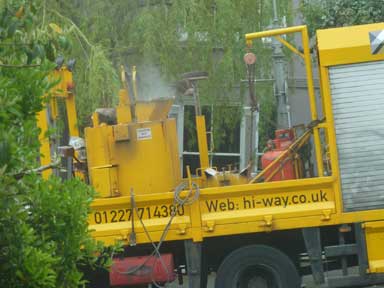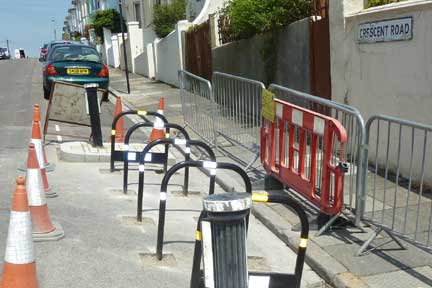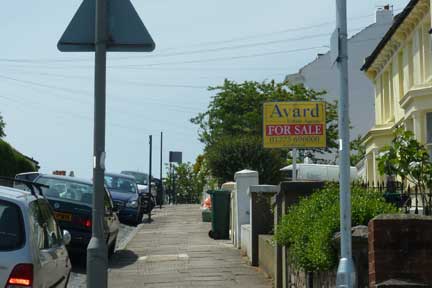Parking-2013-Round Hill CPZ

Round Hill Residents Parking Proposals
Since Monday 1st July 2013, streets in Round Hill as well as streets between Springfield Road and Stanford Avenue have been within the Area J residents parking scheme. They joined streets between Viaduct Rise and Ditchling Rise which have belonged to the Area J extension since September 2010.
Possession of a valid permit entitles residents to park (in spaces allotted to residents parking) throughout the whole area.
Possession of a low emissions vehicle (you get a 50% reduction for this) will contain the cost of the permit to £60 per year, though added to this is the cost of visitors permits. (Note: 2013 prices!)

Will all the line markings be completed?
One concern has been completion of line markings in streets where parked vehicles have impeded access. This prompted a message to the CPZ designer who replied as follows: We are in the process of picking up all of the areas where the liners were unable to line first time around. These areas will be coned and signed, and if needs be vehicles in these areas will be moved to carry out the remaining lining works.
Will people take any notice of restrictions?Another concern, fuelled by a rumour of a slackening of enforcement in the neighbouring Viaduct-Rise area, has been whether the scheme will be adequately enforced and restrictions will be respected. The response to a Freedom Of Information question tabled to The Council would suggest that the rumour is unfounded:
The number of streets in area J has increased several times following consultation and subsequent expansion of the zone. The Viaduct-Rise extension was implemented on 27th September 2010. The data (Excel format) provided by the Council on parking tickets issued (2010-2013) is for the whole of area J and not the ‘original area J’ only. It shows significant enforcement to be both present over time and quite consistent.
Too much signage?

I have followed with interest discussion on whether all the new signs which have gone up are really necessary, especially since there seems to be an abundance of signs in my own street.
My own preference would be to review all the signage put up in the conservation area rather than to focus merely on signs related to the enforcement of the CPZ. While I made comparisons recently with a CPZ delivered for Ealing Borough Council with far fewer signs, our own neighbourhood has hilly streets which may not encourage non-residents to get out of motor vehicles and look carefully for signs. Clear signage reduces the probability of the restrictions being ignored as well as fines being contested.
However, I have to agree that our streets now have too many signs, but more central conservation areas have managed to get The Council to ban flat letting agencies' & estate agents' boards. This may be a better goal. If the abundant traffic signs contribute to enforcement of the restrictions, then when the scheme comes into being on 1st July we should notice a lower density of on-street parking. Dedicated cycle racks should mean fewer bicycles leaning against walls or chained to lamp posts and railings. A CPZ also entails height restrictions for lorries and vans. Tall vehicles, which can create greater eyesores than slim signs, will no longer be permitted to park except for unloading. A CPZ has pros and cons (i.e. all the signage!), but there are balancing factors which should contribute to the visual amenity of our neighbourhood.
Last autumn's CPZ consultation
street-by-street breakdown of results [Round Hill].
street-by-street breakdown of results [London Rd Station North].
Also approved on 15th January 2013 were the recommendations accompanying the report on the Citywide Parking Review, some relating to The Council's timetable for meeting requests for schemes in other areas of the city.
Residents living just outside the boundaries of the Round Hill and London Road Station North schemes (expected to come into effect this summer) realise that they will probably be in line for further displacement.
Triangle Community CPZ consultation expected to follow
Concerns relating to emergency vehicle access (e.g. within narrow streets such as Park Crescent Terrace) have been highlighted by recent events. See The Argus [Friday 16th November 2012]: Woman Fights For Life After Brighton Flat Fire and The Argus report [Monday 19th November] Badly parked cars still block fire engines in Brighton street. The north side of Upper Lewes Road is expected to be included in a Triangle CPZ consultation in the summer of 2014.
Results of the consultation which ended on Friday 9th November 2012 are now known:
Votes in favour or against joining the Area J scheme:
Round Hill:
56% in favour; 44% against; response rate = 34%
Appendix D (PDF) street-by-street breakdown of results.
Map of proposed extension (Round Hill)
London Road Station North area:
56% in favour; 44% against; response rate = 40%
Appendix C (PDF) street-by-street breakdown of results.
Map of proposed extension (London Road Station North)
In terms of these consultations, a response-rate of 30% or over is considered "good". The response rate in Round Hill was 34%; in the London Road Station North area, it was 40%.
Council officers therefore recommended that the schemes should go ahead. Their recommendations were approved by Brighton and Hove City Council's Transport Committee on 15th January 2013, with 5 members voting FOR, 3 AGAINST, and 2 ABSTENTIONS.
The following are the recommendations which The Council's Transport Committee has now approved.
(a) That the extension of the Area J Residents Parking Scheme into the London Road Station north area be progressed to the final design and the Traffic Order advertised
(b) That the extension of the Area J Residents Parking Scheme into the Round Hill area be progressed to the final design and the Traffic Order advertised.
(c) That an order should be placed for all required pay and display equipment to ensure implementation of the extension of the proposed parking schemes if agreed is undertaken as programmed.
The two residents' parking schemes are now expected to be implemented in early summer.
Also approved on 15th January 2013 were the recommendations accompanying the report (PDF) drawn from the responses to the Council's Citywide parking review.
These recommendations relate to parking policy and include a timetable on future resident parking scheme consultations. The policy recommendations would be implemented as soon as possible and the new parking timetable would start as soon as resources were available and in the priority order set by the Transport Committee.
Neighbourhoods such as Wish Park Hove, where there is significant parking stress arising from the volume of vehicles competing for onstreet parking space, felt that they should have been prioritised (above Round Hill and London Road Station North) in the last round. It is important to them that their needs are addressed as soon as the Council has the money to hold another round of consultations.
Inclusion conditional on residents' campaigns The Council did not instantly favour Round Hill in the last round of consultations. Residents affected by the displacement arising from The Viaduct-Rise area scheme (implemented on 27 Sep 2010) campaigned hard, first in the London Road Station North are where a 400-signature petition was in place before Round Hill's 300-signature petition was even started.
The inclusion of Round Hill in last autumn's round of consultations was conditional on sufficient numbers of residents in our neighbourhood requesting reconsultation. Many of the circa 300 who signed the Round Hill petition saw an immediate need for a scheme as they made clear in their comments.
"Too many vehicles" THE REASON for CPZs;
"Displacement" THE MECHANISM BY WHICH THEY SPREAD
The prospect of further displacement (e.g. if Round Hill remained outside a CPZ and all the streets from Springfield Rd to Stanford Av voted to join the Area J scheme) is likely to have influenced local residents' calculations in their stance this time, especially in streets in the NW of Round Hill which experienced a significant increase in parking stress following the implementation of The Viaduct-Rise scheme on 27th Sep 2010.
All Councillors know that CPZs (love them or hate them) spread via the "domino effect" of displacement, though the underlying reason to give residents preferential treatment while rationing the number of cars they can park onstreet in their own neighbourhoods is "too many vehicles competing for limited legal/safe onstreet space".
When footways and junctions are being obstructed making difficulties for pedestrians, emergency & service vehicles, the "real need" for solutions to the problem created by suplus demand for on-street space becomes clear to most.
Areas of Brighton included in the last round of consultations (autumn 2012) were:


As well as Round Hill and London Road Station North, Coldean Area (further to the north) and Moulsecoomb Area (to the north-east) are currently being consulted on parking schemes:


Background to consultation
The decision to re-consult residents is in response to:
[1] difficulties RE parking & access reported by Round Hill residents and Preston Park Ward residents living between Springfield Rd and Stanford Av. i.e. to the N. of London Road Station. These areas have also experienced displacement since residents living in the streets between Viaduct Road and Ditchling Rise joined the Area J scheme in Sep 2011.
[2] two petitions (circa 300-signature and circa 400-signatures) from RH residents and residents living in streets to the N of London Road Station, respectively.
Residents in Wish Park, Hove, who have also requested reconsultation, have expressed disappointment that they haven't been given greater priority in The Council's parking review.
Links to residents' campaigns & newspaper report
+ Preston Park ward
+ The Round Hill Yahoo Web Group different views
+ More residents parking planned for Brighton - The Argus (10 Oct)
THE VIADUCT RISE area CAMPAIGN
Since Monday 27th September 2010, a residents' parking scheme (another name for a Controlled Parking Zone) has been operating in the streets between Viaduct Road and Ditchling Rise known as the Viaduct Rise area. Philip Wells of Calvary Church in Viaduct Road played a leading part in the 7-year residents' campaign which led to this scheme.
ROUND HILL
With online responses taken together with the campaign's paper petition, circa 300 Round Hill residents have expressed a wish to be re-consulted on whether they think a CPZ is now needed in our neighbourhood.
Individual comments from some of our residents who have requested re-consultation.
Are CPZs requested or imposed?
The scenario of "greedy Councils instigating CPZs for money-making purposes" is often referred to by opponents of CPZs.
However, actual debate between political parties has focused in recent years on which neighbourhood should be given the chance to vote for a CPZ first. The Council just hasn't got the resources to hold several consultations and implement several schemes simultaneously.
The current (Green) Council has come under some opposition from both Conservative and Labour Councillors representing residents of Wish Park, West Hove
A group of residents from the above neighbourhood, who were very vocal for reasons which were completely understandable, felt that they should have been given greater priority of progressing towards a scheme than areas which were consulted in 2009 and returned a majority "No Vote".
Parking difficulties in Round Hill
Residents to the NW Round Hill seem to be more affected by displacement from the Viaduct Rise area scheme than those in the SE of our neighbourhood. However, several residents in Roundhill Crescent have been reporting shortage of onstreet parking space and problems of safety and access.
The determination of the Council to enforce the law on illegal pavement parking may well lead to displacement from Hanover and Elm Grove. The SE of Round Hill and the Triangle Community streets stand to experience some of this displacement. "Inconsiderate parking" (on both sides of narrow streets leaving insufficient space for emergency vehicles to pass) becomes "illegal" at the point where it obstructs the highway. The recent report in The Argus [Friday 16th November 2012]: Woman Fights For Life After Brighton Flat Fire has brought the boundaries of "inconsiderate parking" and "illegal parking" into focus.
The Argus report [Monday 19th November] concerning the same street within The Triangle Area (between Round Hill, Lewes Road, and The Level) Badly parked cars still block fire engines in Brighton street reiterates the need for clear guidance on "legal onstreet parking" and for someone (i.e. The police or the Council) to enforce it.
Pavement parking and The Law
From the Royal National Institute of the Blind's website: The Town and Police Clauses Act (1847) makes it an offence to obstruct the pavement and so the police do have the power to take action where they see an offence committed. In addition, the Police and Criminal Evidence Act (1984) gives police officers the power to arrest any person in order to prevent an obstruction to the highway.
However, it seems that the police rarely take action against obstructions. It could be argued that their failure to do so means that they are not complying with their duty to promote equality of opportunity for disabled people. However, there is no real definition of obstructing the pavement so the police in each area tend to interpret it for themselves.
This can cause real problems when trying to get police to take action. RNIB argue that ideally, pavements should not be parked on at all. However, at a minimum, enough clear space should be left to enable a person along with a guide, or with a guide dog, to pass comfortably, and this space should be clear of other obstructions and hazards such as items sticking out from the vehicle, overhanging branches, broken paving etc.